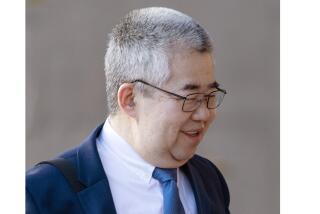Secrecy on Juror Clouds Penn Trial Guilty Verdict
- Share via
The judge in the Sagon Penn murder trial on Wednesday ordered attorneys and court personnel not to discuss whether the 12th juror had affirmed the guilty verdict returned by the jury this week.
In a partial verdict returned Tuesday, Penn was convicted of assault with a deadly weapon for driving a patrol car over San Diego Police Agent Donovan Jacobs.
Although the jury had reached a decision on only one of six charges in the case, the verdict was announced because juror Vernell Hardy went to Kaiser Hospital before court Tuesday morning to deliver a baby. Judge Ben W. Hamrick unsealed the verdict Tuesday and, following court procedure, polled the jurors on their decision. The 11 jurors in court confirmed the verdict.
Hamrick, prosecutor Michael Carpenter and defense attorney Milton Silverman reportedly were scheduled to visit Hardy at the hospital on Wednesday to confirm that she voted to convict Penn of the assault charge.
But Hamrick refused to discuss whether he met with Hardy and ordered everyone connected with the case not to talk to the media.
“There is nothing he can disclose to you right now,” said Hamrick’s clerk, LaRue Slaugh. “Wait until the jury comes back Tuesday morning.”
Both Carpenter and Silverman refused to comment on the latest twist in the three-month-old trial, which has strained police relations in San Diego’s black community because Jacobs mistook Penn for a black gang member and shouted racial epithets, according to numerous witnesses.
“I can’t tell you whether we went to the hospital or whether we’re going to the hospital,” Carpenter said. “I can’t comment.”
Several criminal law experts contacted by The Times said they saw no reason for the cloud of secrecy if Hardy had routinely confirmed the verdict.
Penn faces a minimum prison term of five years after he was convicted of assault with a deadly weapon, a felony that carries a sentence of two to four years. The jury also found that Penn intended to inflict “great bodily harm” when he ran over Jacobs, which automatically adds three years to the prison term.
In arriving at the verdict, the jury rejected the charges of attempted murder and attempted voluntary manslaughter, which require a specific intent to kill.
Penn also is charged with murder in the March 31, 1985, shooting of Police Agent Thomas Riggs and attempted murder in the shootings of Jacobs and Sarah Pina-Ruiz, a civilian who accompanied Riggs in his patrol car. He also faces charges of auto theft and grand theft for fleeing in a patrol car with a police service revolver.
“This could be truly intriguing,” said Sheldon Krantz, dean of the University of San Diego School of Law. Krantz suggested that Hardy’s physical or mental condition during deliberations may have caused her to reconsider her decision.
Peter Hughes, who has practiced law in San Diego since 1958, said that Hardy may have simply disagreed with the verdict.
“That’s one possibility,” Hughes said. “It may be that some question has arisen as to whether she will be able to continue to deliberate.”
John Kaplan, a Stanford University law professor and nationally recognized criminal law expert, said he has never heard of a case where a judge received a verdict without all 12 jurors being present. He said that Hamrick made a mistake by permitting the verdict to be read before Hardy returned.
Hamrick said he wanted to get the verdict on the record so that, if Hardy encountered complications and could not come back, the jury could resume deliberations on the remaining five verdicts with an alternate juror. If the judge had not received the verdict and Hardy did not return, deliberations would have to start all over again.
More to Read
Sign up for Essential California
The most important California stories and recommendations in your inbox every morning.
You may occasionally receive promotional content from the Los Angeles Times.













